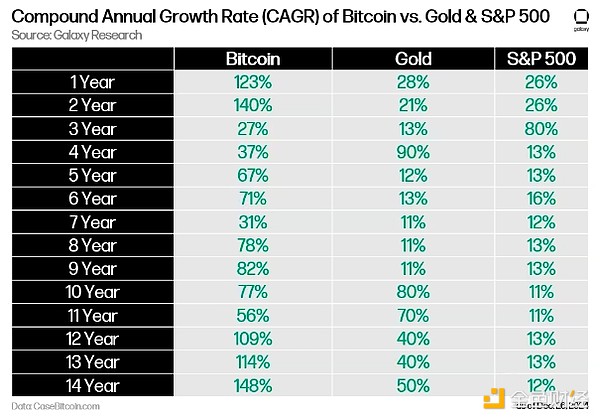
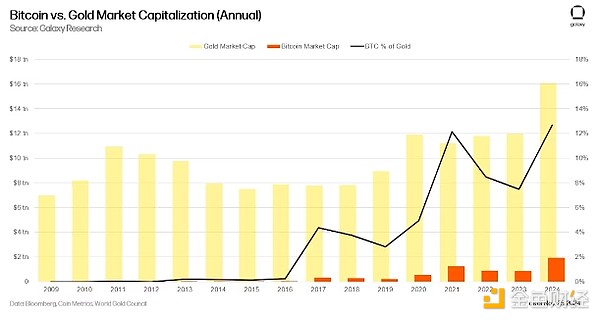 By 2025, the total assets under management (AUM) of the US spot Bitcoin ETP will exceed $250 billion. In 2024, Bitcoin ETPs absorbed over $36 billion in net inflows, making it the largest ETP launch in history. 13F filings show that many of the world's major hedge funds, including Millennium, Tudor, and D.E. Shaw, have purchased Bitcoin ETPs, and the Wisconsin State Investment Board (SWIB) has also purchased Bitcoin ETPs. In just one year, the AUM of Bitcoin ETPs will be only 19% ($ 24 billion) behind the AUM of all physical gold ETPs in the US.
By 2025, the total assets under management (AUM) of the US spot Bitcoin ETP will exceed $250 billion. In 2024, Bitcoin ETPs absorbed over $36 billion in net inflows, making it the largest ETP launch in history. 13F filings show that many of the world's major hedge funds, including Millennium, Tudor, and D.E. Shaw, have purchased Bitcoin ETPs, and the Wisconsin State Investment Board (SWIB) has also purchased Bitcoin ETPs. In just one year, the AUM of Bitcoin ETPs will be only 19% ($ 24 billion) behind the AUM of all physical gold ETPs in the US.
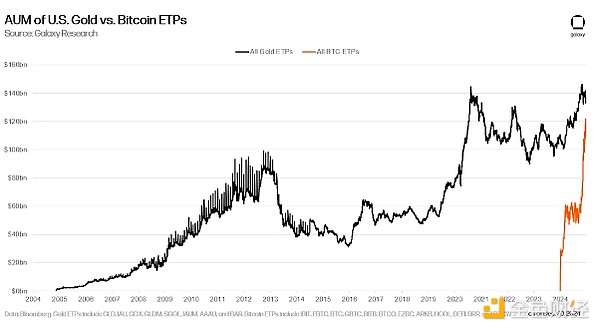 By 2025, Bitcoin will once again be one of the best performing assets globally on a risk-adjusted basis. The above AUM comparison is due to the record capital inflows and Bitcoin price appreciation in 2024. In fact, Bitcoin is the third best performing asset on a risk-adjusted basis. Notably, the best Sharpe ratio belongs to MicroStrategy - a self-proclaimed "Bitcoin treasury company".
By 2025, Bitcoin will once again be one of the best performing assets globally on a risk-adjusted basis. The above AUM comparison is due to the record capital inflows and Bitcoin price appreciation in 2024. In fact, Bitcoin is the third best performing asset on a risk-adjusted basis. Notably, the best Sharpe ratio belongs to MicroStrategy - a self-proclaimed "Bitcoin treasury company".
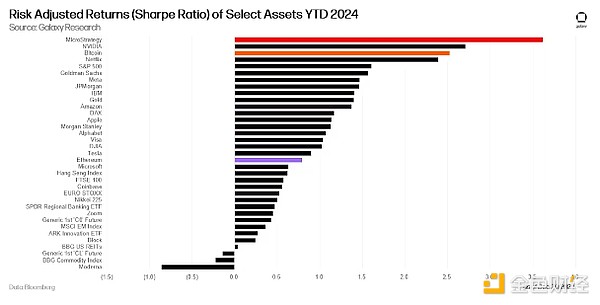 At least one top wealth management platform will announce a recommended 2% or higher Bitcoin allocation. For various reasons, including maturity, internal education, and compliance requirements, no major wealth management firms or asset managers have formally added Bitcoin allocation recommendations to their model investment portfolios. This will change in 2025, further increasing dollar flows and assets under management.
Five Nasdaq 100 index companies and five countries will announce that they have added Bitcoin to their balance sheets or sovereign wealth funds. Whether for strategic, portfolio diversification, or trade settlement reasons, Bitcoin will begin to find a place on the balance sheets of major corporations and sovereign allocators. Competition between nation-states, particularly non-aligned countries, countries with large sovereign wealth funds, and even countries hostile to the US, will drive the adoption of strategies to mine or otherwise acquire Bitcoin.
At least one top wealth management platform will announce a recommended 2% or higher Bitcoin allocation. For various reasons, including maturity, internal education, and compliance requirements, no major wealth management firms or asset managers have formally added Bitcoin allocation recommendations to their model investment portfolios. This will change in 2025, further increasing dollar flows and assets under management.
Five Nasdaq 100 index companies and five countries will announce that they have added Bitcoin to their balance sheets or sovereign wealth funds. Whether for strategic, portfolio diversification, or trade settlement reasons, Bitcoin will begin to find a place on the balance sheets of major corporations and sovereign allocators. Competition between nation-states, particularly non-aligned countries, countries with large sovereign wealth funds, and even countries hostile to the US, will drive the adoption of strategies to mine or otherwise acquire Bitcoin.
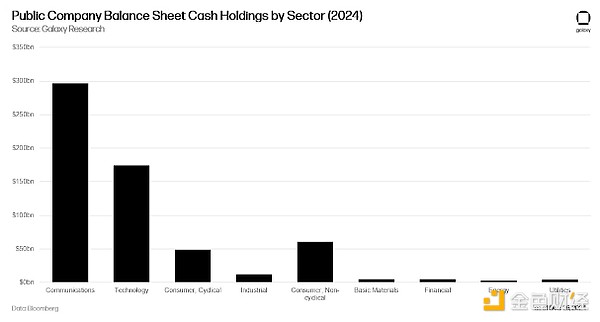 Bitcoin developers will reach consensus on the next protocol upgrade in 2025. Since 2020, Bitcoin core developers have been debating which operations can safely enhance transaction programmability. As of December 2024, the two most supported pending operations for enhanced transaction programmability are OP_CTV (BIP 119) and OP_CAT (BIP 347). Reaching consensus on soft forks has been a time-consuming and rare feat since Bitcoin's inception, and the next soft fork upgrade will include OP_CTV, OP_CSFS, and/or OP_CAT -Gabe Parker.
More than half of the top 20 publicly traded Bitcoin miners by market cap will announce transformations into hyperscale enterprises, AI, or high-performance computing (HPC) companies or partnerships. The growing demand for AI computing will lead Bitcoin miners to increasingly retrofit, build HPC infrastructure, or co-locate HPC infrastructure with Bitcoin mining facilities. This will limit year-over-year hash rate growth, reaching 1.1 zetahash by the end of 2025.
Bitcoin DeFi (considered the total BTC locked in DeFi smart contracts and deposited into staking protocols) will nearly double by 2025. As of December 2024, over $11 billion in wrapped BTC has been locked in DeFi smart contracts. Notably, over 70% of the locked BTC is used as collateral in lending protocols. An additional $4.2 billion is deposited through Bitcoin's largest staking protocol, Babylon. The Bitcoin DeFi market, currently valued at $15.4 billion, is expected to expand significantly across multiple fronts by 2025, including existing DeFi protocols on Ethereum L1/L2, new DeFi protocols on Bitcoin L2, and staking layers like Babylon. The current market size doubling is likely driven by several key growth factors: 150% year-over-year growth in cbBTC supply, 30% growth in WBTC supply, Babylon reaching $8 billion in TVL, and new Bitcoin L2 achieving $4 billion in DeFi TVL.
Bitcoin developers will reach consensus on the next protocol upgrade in 2025. Since 2020, Bitcoin core developers have been debating which operations can safely enhance transaction programmability. As of December 2024, the two most supported pending operations for enhanced transaction programmability are OP_CTV (BIP 119) and OP_CAT (BIP 347). Reaching consensus on soft forks has been a time-consuming and rare feat since Bitcoin's inception, and the next soft fork upgrade will include OP_CTV, OP_CSFS, and/or OP_CAT -Gabe Parker.
More than half of the top 20 publicly traded Bitcoin miners by market cap will announce transformations into hyperscale enterprises, AI, or high-performance computing (HPC) companies or partnerships. The growing demand for AI computing will lead Bitcoin miners to increasingly retrofit, build HPC infrastructure, or co-locate HPC infrastructure with Bitcoin mining facilities. This will limit year-over-year hash rate growth, reaching 1.1 zetahash by the end of 2025.
Bitcoin DeFi (considered the total BTC locked in DeFi smart contracts and deposited into staking protocols) will nearly double by 2025. As of December 2024, over $11 billion in wrapped BTC has been locked in DeFi smart contracts. Notably, over 70% of the locked BTC is used as collateral in lending protocols. An additional $4.2 billion is deposited through Bitcoin's largest staking protocol, Babylon. The Bitcoin DeFi market, currently valued at $15.4 billion, is expected to expand significantly across multiple fronts by 2025, including existing DeFi protocols on Ethereum L1/L2, new DeFi protocols on Bitcoin L2, and staking layers like Babylon. The current market size doubling is likely driven by several key growth factors: 150% year-over-year growth in cbBTC supply, 30% growth in WBTC supply, Babylon reaching $8 billion in TVL, and new Bitcoin L2 achieving $4 billion in DeFi TVL.
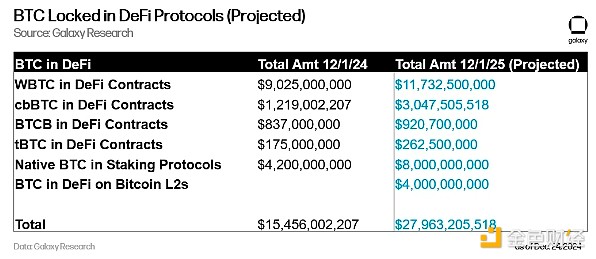 Ethereum
By 2025, Ethereum's trading price will exceed $5,500. The relaxation of regulatory resistance to DeFi and staking will drive Ethereum to new all-time highs in 2025. New partnerships between DeFi and TradFi, perhaps within new regulatory sandboxes, will ultimately allow traditional capital markets to seriously experiment with public blockchains, Ethereum, and its ecosystem seeing the greatest share of usage. Enterprises will increasingly experiment with their own Layer 2 networks, primarily based on Ethereum technology. Some games leveraging public blockchains will find product-market fit, and NFT trading volume will rebound significantly.
Ethereum's staking rate will exceed 50%. The Trump administration may provide clearer regulation and guidance for the crypto industry. Demand for staking will continue to rise, potentially exceeding half of Ethereum's circulating supply by the end of 2025, prompting Ethereum developers to seriously consider changes to the network's monetary policy. More importantly, the increase in staking will drive greater demand and value flowing through Ethereum staking pools like Lido and Coinbase, as well as re-staking protocols like EigenLayer and Symbiotic.
Ethereum
By 2025, Ethereum's trading price will exceed $5,500. The relaxation of regulatory resistance to DeFi and staking will drive Ethereum to new all-time highs in 2025. New partnerships between DeFi and TradFi, perhaps within new regulatory sandboxes, will ultimately allow traditional capital markets to seriously experiment with public blockchains, Ethereum, and its ecosystem seeing the greatest share of usage. Enterprises will increasingly experiment with their own Layer 2 networks, primarily based on Ethereum technology. Some games leveraging public blockchains will find product-market fit, and NFT trading volume will rebound significantly.
Ethereum's staking rate will exceed 50%. The Trump administration may provide clearer regulation and guidance for the crypto industry. Demand for staking will continue to rise, potentially exceeding half of Ethereum's circulating supply by the end of 2025, prompting Ethereum developers to seriously consider changes to the network's monetary policy. More importantly, the increase in staking will drive greater demand and value flowing through Ethereum staking pools like Lido and Coinbase, as well as re-staking protocols like EigenLayer and Symbiotic.
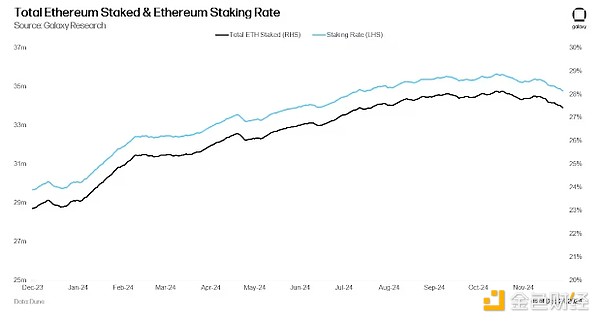 The ETH/BTC ratio is one of the most closely watched currency pairs in all of crypto, and it has been in a dangerous downtrend since Ethereum's "Merge" upgrade to Proof-of-Stake in September 2022. However, the expected regulatory shift will help Ethereum and its application layer, particularly DeFi, reignite investor interest in the world's second-largest value blockchain network.
The ETH/BTC ratio is one of the most closely watched currency pairs in all of crypto, and it has been in a dangerous downtrend since Ethereum's "Merge" upgrade to Proof-of-Stake in September 2022. However, the expected regulatory shift will help Ethereum and its application layer, particularly DeFi, reignite investor interest in the world's second-largest value blockchain network.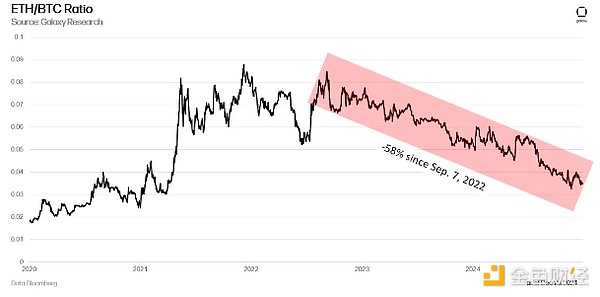
By 2025, L2 as a whole will generate more economic activity than Alt L1. The percentage of L2 fees to Alt L1 fees (currently in the single digits) will exceed 25% of the total Alt L1 fees by the end of the year. L2 will approach expansion limits early this year, leading to frequent spikes in transaction fees, which will require changes to Gas limits and Blob market parameters. However, other technical solutions (such as Reth clients or altVMs like Arbitrum Stylus) will provide higher efficiency for aggregators to keep transaction costs at usable levels.
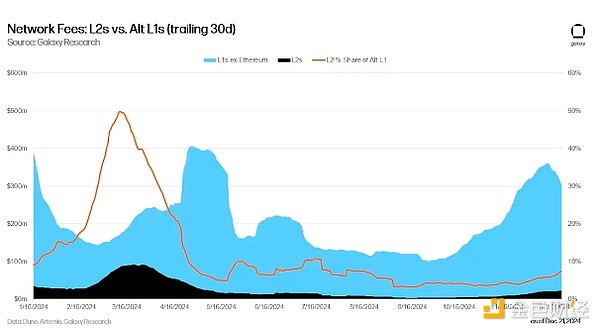
Decentralized Finance (DeFi)
DeFi will enter a "dividend era" as on-chain applications distribute at least $1 billion to users and token holders through vault funds and revenue sharing. As DeFi regulation becomes clearer, value sharing by on-chain applications will expand. Applications like Ethena and Aave have already initiated discussions or passed proposals to implement their fee switches, which are infrastructure for distributing value to users. Other protocols that previously rejected such mechanisms, including Uniswap and Lido, may reconsider their positions due to regulatory clarity and competitive dynamics. The combination of a permissive regulatory environment and increased on-chain activity suggests that protocols may engage in buybacks and direct revenue sharing at a faster pace than previously observed.
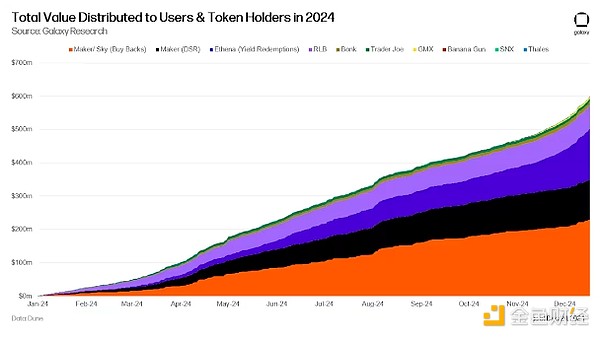
On-chain governance will revive, and applications will experiment with future governance models. The total number of active voters will increase by at least 20%. On-chain governance has historically faced two issues: 1) lack of participation, and 2) lack of voting diversity, with most proposals passing by overwhelming majorities. However, the easing of regulatory tensions has been a limiting factor for on-chain voting, and Polymarket's recent success suggests that both of these will improve by 2025. By 2025, applications will begin to transition from traditional governance models to future governance models, improving voting diversity, and regulatory tailwinds will facilitate greater governance participation.
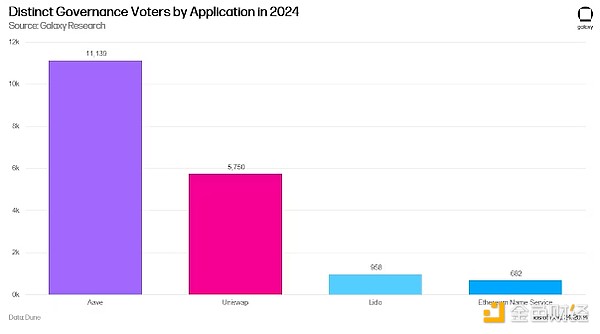
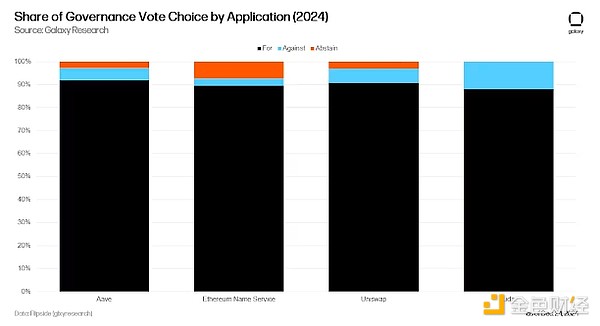
Banking and Stablecoins
The Office of the Comptroller of the Currency (OCC) will create a pathway for banks in various countries to custody digital assets, guiding the four major global custodian banks - Bank of New York Mellon, State Street, JPMorgan Chase, and Citibank - to provide digital asset services.
TradFi partners will support the launch of at least 10 stablecoins. From 2021 to 2024, stablecoins experienced rapid growth, with the current number of projects reaching 202, including several closely tied to traditional finance (TradFi). In addition to the number of stablecoins launched, their trading volume growth has surpassed major payment networks like ACH (around 1%) and Visa (around 7%). By 2024, stablecoins will become increasingly integrated into the global financial system. For example, FV Bank, which is licensed in the US, now supports direct stablecoin deposits, while Japan's three megabanks are collaborating with SWIFT through Project Pax to enable faster and more cost-effective cross-border fund flows. Payment platforms are also building stablecoin infrastructure. For instance, PayPal has launched its own stablecoin PYUSD on the Solana blockchain, and Stripe has acquired Bridge to natively support stablecoins. Additionally, asset managers like VanEck and BlackRock are partnering with stablecoin projects to establish a foothold in this space. Looking ahead, as regulation becomes clearer, TradFi participants are expected to integrate stablecoins into their operations to stay ahead of the curve, while early movers are preparing to gain an advantage by building infrastructure for future business development.
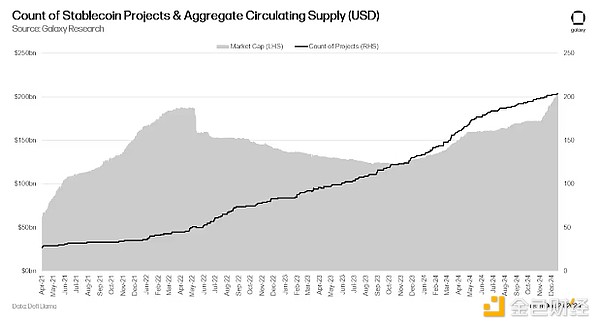
By 2025, the total supply of stablecoins will double, exceeding $400 billion. Stablecoins are increasingly finding product-market fit for payments, remittances, and settlements. Clearer regulation of existing stablecoin issuers as well as traditional banks, trust companies, and deposit-taking institutions will lead to an explosive growth in stablecoin supply by 2025.
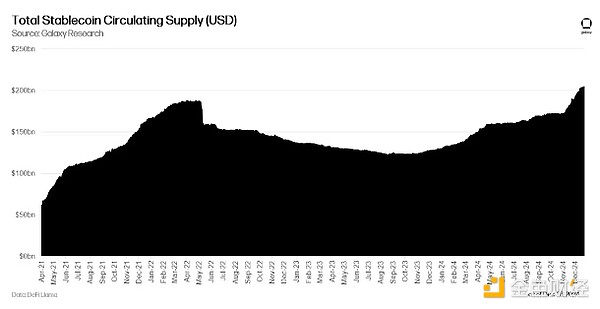
Tether's long-term market dominance will drop below 50%, challenged by yield alternatives such as Blackrock's BUIDL, Ethena's USDe, and even Coinbase/Circle's USDC Rewards. As Tether internalizes the yield income from USDT reserves to fund portfolio investments, the marketing spend by stablecoin issuers/protocols to pass on yield will drive existing users to migrate from Tether to their yield solutions. Coinbase's rewards for user balances on its exchange and wallet will become a powerful hook, driving adoption across the DeFi ecosystem and potentially being integrated by fintech companies to enable new business models. In response, Tether will start passing on the income from collateral holdings to USDT holders, and may even offer new competitive yield products, such as delta-neutral stablecoins.
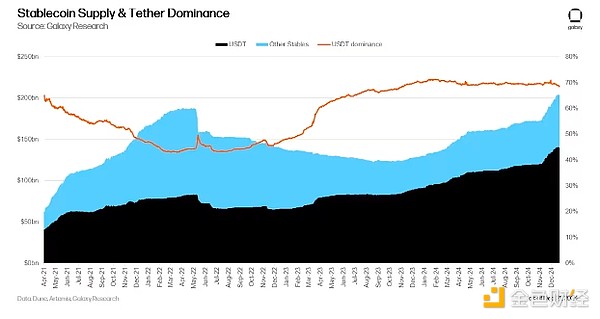
Investments and Policy
Crypto venture capital investments will exceed $150 billion, growing more than 50% year-over-year. Driven by the increased interest of allocators in risk-on activities and the improved regulatory clarity around cryptocurrencies, the surge in venture capital activity will be fueled. Crypto venture capital financing has historically lagged broader crypto market trends, and there will be a certain degree of "catch-up" in the next four quarters.
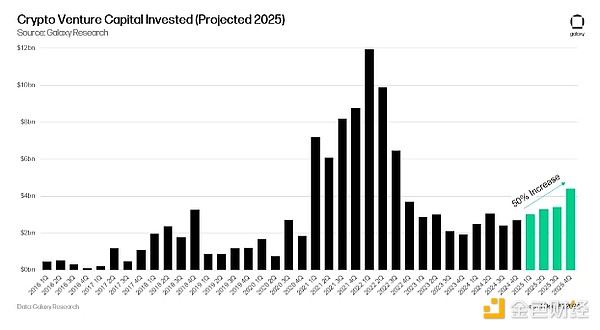
Stablecoin legislation will be passed in both the House and Senate and signed into law by President Trump in 2025, but market structure legislation will not. Formal legislation establishing a registration and oversight regime for US stablecoin issuers will be passed with bipartisan support and signed into law by the end of the year, along with expected relaxation of restrictions on banks, trusts, and deposit-taking institutions, leading to a significant increase in stablecoin adoption. Market structure - establishing registration, disclosure, and oversight requirements for token issuers and exchanges, or adjusting existing SEC and CFTC rules to encompass them - is more complex and will not be completed, passed, and signed into law by 2025.
The US government will not purchase Bitcoin in 2025, but will create a treasury using its existing Bitcoin holdings, and some actions will be taken within departments and agencies to review an expanded Bitcoin reserve policy.
The U.S. Securities and Exchange Commission will investigate the first so-called "special purpose broker-dealer" Prometheum. A previously unknown broker-dealer has suddenly appeared, coinciding with the overall view of the U.S. Securities and Exchange Commission. Chairman Gensler's views on the status of digital asset securities drew attention in 2023, especially when this obscure company obtained the first new category broker-dealer license. According to FINRA records, the CEO was condemned by Republican members of the House Financial Services Committee. Republicans called on the Department of Justice and the U.S. Securities and Exchange Commission to investigate Prometheum's "relationship with China," while others pointed to violations in its fundraising and reporting. Whether or not Prometheum is investigated, the special purpose broker-dealer license will likely be abolished by 2025. Dogecoin will ultimately reach $1, and the world's largest and oldest Meme coin will have a market capitalization of $100 billion. However, the market capitalization of Dogecoin will be overshadowed by the efficiency department, which will determine and successfully implement reductions exceeding Dogecoin's 2025 high water mark.




